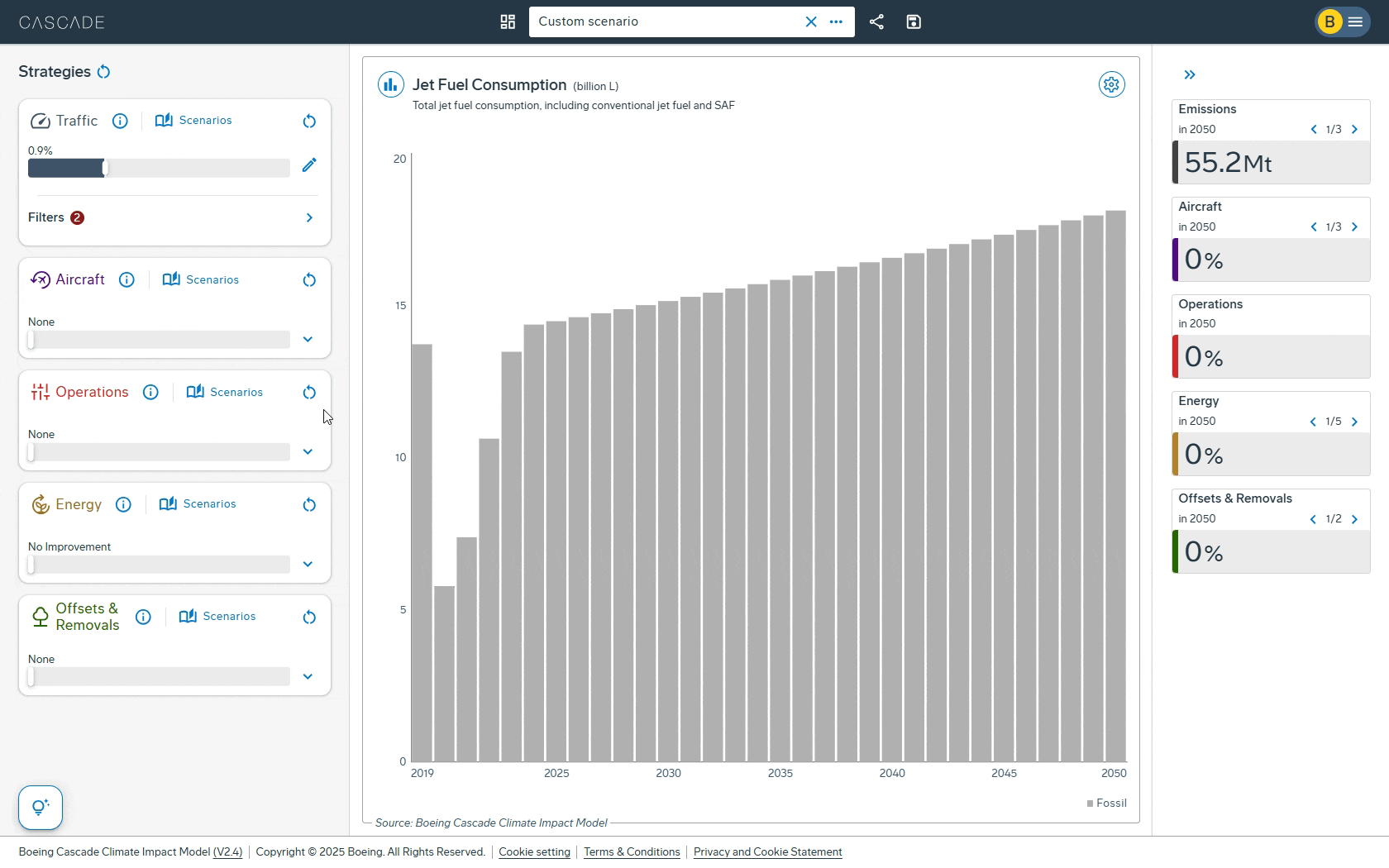The UK has been taking a leadership role in aviation decarbonization. As part of the UK’s committed to achieve net-zero aviation by 2050, this year the UK’s sustainable aviation fuel (SAF) mandate went into effect. The UK’s SAF mandate, requires fuel suppliers to meet gradually increasing SAF targets – starting at 2% in 2025, rising to 10% by 2030, and reaching 22% by 2040.
De-risking SAF scaling in the UK
How Cascade supported a policy-ready roadmap for operationalizing the UK SAF mandateAs detailed in the recent white paper, Clear Skies Ahead: Ensuring Success for the UK SAF Mandate, presented to the UK government, successfully delivering the SAF required to meet the mandate remains a challenge. Authored by energy transition expert Philip New and commissioned by a wide group of stakeholders including Boeing, the study identifies risks and evaluates market dynamics for a successful implementation of the UK SAF mandate and suggests practical mitigation strategies.
As part of the white paper, the latest version of Cascade was used to analyze how the UK’s SAF mandate could be turned into reality through modeling assumptions such as total fuel demand, volumes of SAF and carbon savings, and jet fuel usage after emissions reductions from aircraft and operations.
UK’s policy and economic opportunity
To address industry concerns around economic risk, the government is in the process of passing the law to create a Revenue Certainty Mechanism (RCM), providing a financial safety net to early SAF producers in the UK by stabilizing revenue and encouraging the investment necessary to meet mandated blending targets.
“Achieving the UK’s SAF mandate is vital not only for global aviation decarbonization but also for strengthening the UK’s national energy security and economic resilience,” says Steve Gillard, chair of the UK Jet Zero Council SAF Delivery Group and Boeing’s regional sustainability director for Europe & METACA. “The Revenue Certainty Mechanism is a key enabler to do so, providing the investment confidence needed to accelerate SAF production.”
The report outlines that without revenue certainty provided by the RCM, the UK SAF uptake could fail to meet the 2030 mandate. De-risking initial investments is vital for mandate fulfillment in its early years and maintaining confidence going forward.
If successfully implemented what will be the impact of the UK SAF mandate?
SAF is a key lever in delivering the UK’s net zero aviation ambitions. If met, the SAF mandate will lead to a 15% reduction in aviation emissions in 2040 on flights departing the UK (a saving of 6.3 Mt of CO2). However, the sector faces significant challenges including limited supply, intense competition for feedstocks, and cost pressures.
The UK’s SAF mandate provides a crucial, bankable demand signal that underpins investment, but it cannot be viewed in isolation. To ensure the mandate’s long-term success, it needs to be complemented with additional policy interventions that address price volatility, feedstock availability, and cost risks.
“RCM is central to mitigating price risks, but further measures are needed to de-risk the entire value chain,” Gillard highlights. “Continuing to establish strategic coordination with agencies such as UK Export Finance and the National Wealth Fund is critical to lower capital costs and ensure the UK remains a globally competitive and attractive destination for sustainable aviation investment.”
Cascade supported a policy-ready roadmap for operationalizing the UK SAF mandate
But how do policymakers ensure the policy is effective, resilient, and achievable, especially when global SAF supply remains limited? That’s where Cascade plays a critical role.
“SAF policy design needs to be pressure-tested against actual conditions to ensure it’s both ambitious and achievable,” says Philip New, author of the report. “Partnering with Boeing’s Cascade team enabled us to explore a range of realistic scenarios, leveraging custom modelling capabilities that reflect the unique needs and conditions of the UK SAF mandate and test potential implications of policy, market behavior, and technology readiness.”
This pressure-testing was achieved using the new customizable decarbonization scenarios in Cascade. The latest version of Cascade includes the capability to define precise SAF uptake trajectories by feedstock type, production pathway, and policy setting. This new capability supports more accurate recreation of local SAF policies such as the UK SAF mandate by enabling users to set intermediate targets for any year between 2019 and 2050, match SAF uptake to industry targets or model the evolution of electricity grids across regions.
The user can also customize the carbon intensity of the various production pathways. The UK mandate is expressed as a volumetric percentage of total aviation fuel, but compliance could be achieved through carbon intensity (CI) adjusted volumes of SAF. Cascade was used to model mandate compliance under different SAF pathway combinations and CI assumptions, emphasizing significant differences in emissions savings based on feedstock and technology choices.
“Driving the modelling for the Clear Skies Ahead report in support of the UK’s SAF ambitions was an invaluable opportunity to demonstrate how precisely Cascade can map the implications of different SAF policy scenarios,” explains Lily Meech, energy carrier engineer with Boeing’s Cascade team. “Our work helps illuminate the complex interplay between fuel volumes, carbon intensity, and emissions reductions, providing critical insights for more informed decision-making.”
 To learn more about de-risking SAF in the UK, read the full white paper Clear Skies Ahead
To learn more about de-risking SAF in the UK, read the full white paper Clear Skies Ahead